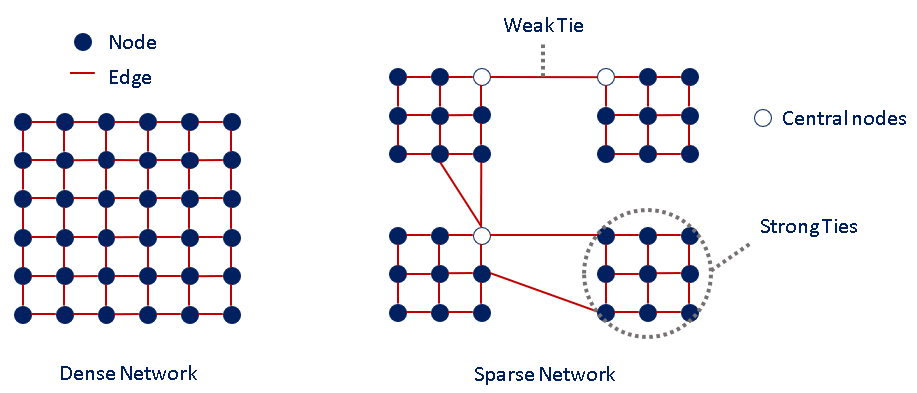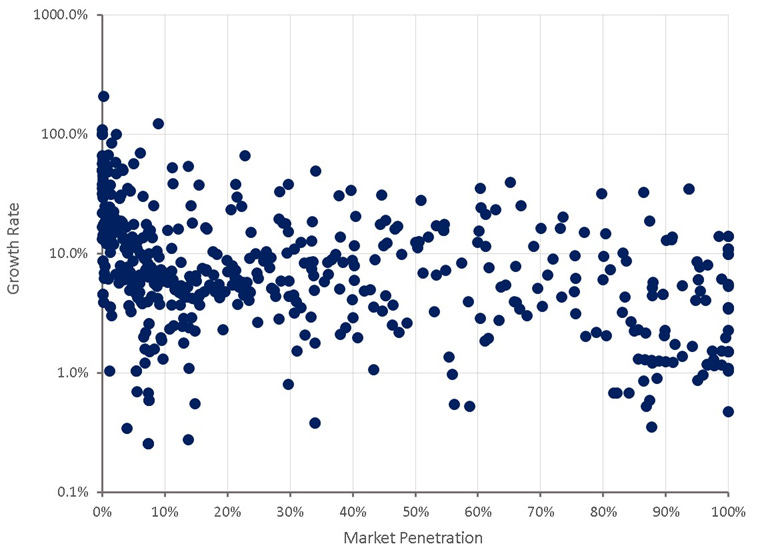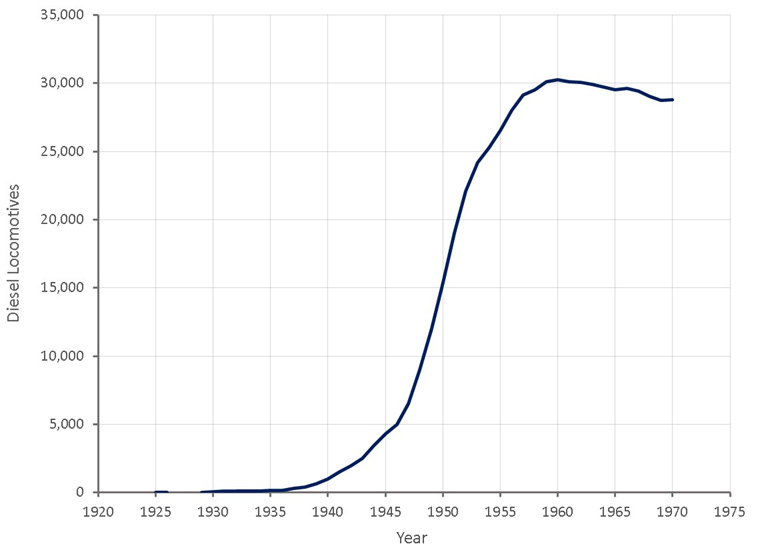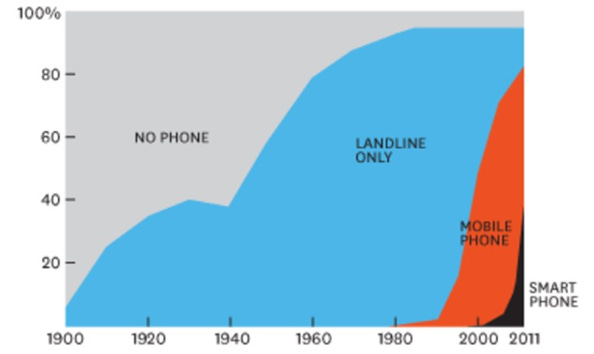The Diffusion of Innovations
Diffusion is an important part of the innovation process and is a contributor to productivity growth.
Regardless of the importance of a new technology, it will not impact the economy until it has sufficiently diffused through the user base. The speed with which this occurs is an important determinant of the rate of productivity growth, making understanding the diffusion process an important component of assessing the likely impact of a new technology. The diffusion of a new technology is an important part of the innovation process and is a well studied phenomena. The rapid adoption of modern technologies like smartphones is often used as proof that the adoption of technologies is accelerating but this belief can only be determined by assessing the drivers of diffusion to understand why adoption is relatively fast or slow.
Theory
When an innovation is introduced it must diffuse through the user base before its full potential can be realised, a process that involves:
An innovation
Communication channels
Time
Members of a social system
An innovation is any product, process or organisational system that is perceived as new by potential adopters of the innovation.
If a technology is a physical product it has two components:
Hardware - tool that embodies the technology
Software - knowledge base for the tool
After an innovation is introduced, potential adopters are likely to be wary about the technology due to uncertainty regarding the cause-effect relationships involved in achieving a desired outcome or uncertainty about the innovation's expected consequences. To over come hesitancy, information that reduces this uncertainty is required and this information comes through communication channels.
Communication involves the creation and sharing of information about an innovation. This can come through:
Mass Media - creates awareness
Interpersonal Channels - more effective at changing attitudes towards a new idea
Interpersonal communication is more important overall but mass media may dominate during the early stages of diffusion when awareness is low. Media has shifted from local to regional then national and now increasingly international distribution. This has expanded the reach of mass media which should lead to users becoming aware of an innovation earlier. The introduction of the internet and in particular social media has greatly enhanced interpersonal communication, which should lead to users changing their attitude towards an innovation more rapidly.
Communication is more effective through homophilous individuals, as their similarity creates trust which reduces uncertainty. Diffusion is more likely to occur through heterophilous individuals though as they are more likely to have different information. The diffusion of an innovation is therefore dependent on the structure of the social system, making diffusion similar to virality in social networks. Virality is typically quantified using the viral coefficient, in this case the number of new adopters the average adopter generates. A viral coefficient above 1 leads to self-propagation of an innovation amongst a population and a higher coefficient results in faster diffusion.
Equation 1: Viral Coefficient
(source: Created by author)
Strong ties are likely to occur between homophilous individuals whereas weak ties are likely to occur between heterophilous individuals. Strong ties represent a deeper relationship, such as between family, friends and colleagues. In comparison, weak ties are more casual, like between acquaintances or strangers with a common cultural background. Weak ties have cohesive power though and define relations between clusters, making them important determinants of the diffusion of an innovation. The degree of overlap between two individuals’ connections are likely to be directly related to the strength of the tie between them, thereby influencing the diffusion of information. Other important properties of social networks include:
Size – number of nodes (potential adopters) or edges (relationship between potential adopters)
Density – ratio of the number of edges to the maximum possible number of edges
Degree – the degree of a node is the number of edges connected to it
Clustering Coefficient - the ratio of existing links connecting a node's neighbours to each other to the maximum possible number of such links
Centrality – there are a number of proposed measures, but they all aim to identify important nodes
Figure 1: Social Network Structures
(source: Created by author)
Once an individual or organisation is aware of an innovation they must make a decision whether to adopt or not. This decision involves:
Knowledge – awareness of the innovation.
Persuasion – involves a reduction in uncertainty regarding the innovation through communication channels.
Decision – decision to adopt an innovation or not. Innovation decisions may be made by individuals, by a collective decision of the group or dictated top-down by an authority figure.
Implementation – the implementation of an innovation may involve significant effort like the installation of associated infrastructure, the development of complementary technologies and the development of technical knowledge.
Confirmation – After an innovation has been adopted, users will generally receive feedback that indicates whether they made the correct decision or not.
There are five main attributes of an innovation that determine how it will diffuse:
Relative Advantage – the larger the relative advantage the more likely a technology is to diffuse and diffuse quickly. This becomes more important when there are barriers preventing the adoption of a technology. For example, if a new technology is complex and requires significant new technical knowledge, making prior knowledge redundant, potential users may be reluctant to adopt. Relative advantage often depends on adoption though, as the performance and cost of a technology generally improves with the cumulative production volume. This can make it difficult for a technology to gain traction if initial performance is low. It can also mean that a slightly higher initial performance can lead to dramatically faster adoption, as experience compounds faster.
Figure 2: Performance Improvement with Volume
(source: Created by author)
Compatibility – dependent on the facilitating structure, policy and existing technical knowledge. The less compatible an innovation is with the existing system, the longer it will take to diffuse.
Complexity – familiarity with the technology or similar technologies reduces the burden of complexity. The more complex a technology is, the longer it will take to diffuse.
Trialability – is the ability to try an innovation before adoption. This helps to reduce uncertainty and speeds up the decision process.
Observability – if a an innovation is easily observed as it spreads through society it helps to create awareness and reduce uncertainty regarding the innovation.
The rate of diffusion is the relative speed with which an innovation is adopted by members of a social system. This process often occurs slowly initially, before a tipping point is reached (typically 10-25% adoption) where adoption accelerates and then tapers off again as market saturation is approached. Take off in adoption generally occurs when opinion leaders in a system adopt a new idea, as this accelerates the knowledge and persuasion steps of the diffusion process. Individuals can generally be grouped by their propensity to adopt an innovation based on their characteristics. There are 5 adopter categories:
Innovators - tend to have higher socioeconomic status and be better educated (approximately 2.5% of the population).
Early Adopters - approximately 13.5% of the population
Early Majority - approximately 34% of the population
Late Majority - approximately 34% of the population
Laggards - approximately 16% of the population
Examples
Based on the diffusion of past innovations, adoption occurs rapidly and declines as market saturation is approached. Growth can be highly variable in some cases during the early stages of adoption but generally becomes more stable as adoption increases. Growth is also relatively persistent, with innovations that diffuse rapidly initially generally continuing to diffuse rapidly and innovations that initially diffuse slowly generally continuing to diffuse slowly.
Figure 3: Adoption Growth versus Market Penetration
(source: Created by author using data from ourworldindata)
Diesel locomotives are exemplary of the typical s-shaped adoption curve. Adoption of diesel locomotives was relatively rapid for the following reasons:
Relative advantage – large (greater performance and lower operating costs)
Compatibility – high (utilized existing infrastructure)
Complexity – moderate (knowledge of diesel engines needed)
Trialability – low
Observability – high
Figure 4: Adoption of Diesel Locomotives
(source: Created by author using data from ourworldindata)
The telegram is a good example of how the use of a technology changes as it becomes redundant. The rate at which this process occurs is dependent on the diffusion of the innovation that is replacing it.
Figure 5: Telegram Usage
(source: Created by author using data from ourworldindata)
The internet has diffused globally at a relatively rapid pace in comparison to many other innovations.
Relative advantage – large, as it enables both instantaneous and asynchronous communication and richer content communication.
Compatibility – moderate, as people were generally already familiar with PCs and using telephones. They had to purchase a modem and subscribe with an ISP though. They also had to become familiar with navigating the internet, using email etc. and if they were creating their own web pages they had to learn HTML, CSS etc.
Complexity – low
Trialability – high due to the availability of internet cafes, libraries etc.
Observability – low as it is difficult to observe that someone uses the internet unless you already use the internet as well.
In comparison cryptocurrencies are diffusing at a slower pace than the internet, particularly when considering use outside of speculation. Although cryptocurrencies have vocal opinion leaders and change agents which may accelerate adoption. The prospect of profits has probably attracted the vast majority of cryptocurrency holders and without this, usage would likely be much lower.
Relative Advantage – small, although this depends on the features people want in a value transfer system.
Compatibility – moderate as cryptocurrencies utilise existing internet infrastructure but have also required significant developments in the facilitating structure, like mining hardware, exchanges and wallets.
Complexity – initially high, although there are applications available now which have lowered the barriers to adoption.
Trialability – high, as it is easy to try using cryptocurrencies with only a small financial commitment required.
Observability – moderate, as many cryptocurrencies users are vocal about their usage and support of cryptocurrencies, increasing their visibility.
Accelerating Adoption
It has been noted that the diffusion of technologies has been accelerating and this trend has been projected by the likes of Ray Kurzweil to support the notion of an impending singularity. Kurzweil's work assumes an ever accelerating rate of diffusion without giving consideration to the diffusion process. Technology adoption is accelerating due to improved communication channels and denser social networks. In addition, many recent innovations have been from within the same paradigm (e.g. electronic devices) and hence have been compatible with the existing facilitating structure. If a paradigm shift were to occur if would not be surprising for a significant decrease in the rate of diffusion to occur due to compatibility and complexity issues.
Figure 6: Accelerating Technology Adoption
(source: pewresearch)
The adoption of communication devices is often used as an example of the pace of technology adoption accelerating, but much of this can be explained by the properties of those innovations rather than changes to the social system. The phone was a revolutionary communication device when first introduced that needed to reach a critical mass of users before it became useful. It also required significant changes to the facilitating structure as it was implemented, like the training of personnel and the building of infrastructure. The mobile phone was an incremental improvement over the landline phone, which was instantly beneficial as it largely used the existing facilitating structure. The complexity of communication devices has increased over time, but so has user familiarity and as a result it would be easier for a landline user to switch to a mobile phone than for a non-user to begin using a landline. The more similar an innovation is to existing innovations, the more likely it is to be adopted and this would have been a significant contributor to the faster adoption of mobile phones and smart phones. Observability is also much higher for mobile phones and smart phones and should have contributed to faster diffusion.
Improving communication channels is also leading to faster diffusion of innovations. Mass media is now ubiquitous and social media has made social networks much more dense than in the past. Early adopters of technology generally have higher socioeconomic status and it could also be the case that as economies become more developed and incomes increase, technology adoption accelerates.
Figure 7: Diffusion of Telephones
(source: hbr)
Conclusion
An innovation must diffuse through the economy before it can have an impact and the rate of diffusion is an important determinant of productivity growth. The diffusion of an innovation is determined by the properties of the innovation and the social system through which it propagates. Modern communication channels allow for the rapid dissemination of rich information, which reduces uncertainty and allows for faster decisions regarding adoption. Social networks globally have become denser as social media, multi-national organisations etc. have enabled the proliferation of weak ties. Changes to communication channels and social systems may largely be responsible for the changing pace of the diffusion of innovations. Many recent innovations have also been part of existing technology paradigms, allowing them to diffuse faster. If a paradigm shift were to occur (nanotechnology, biotechnology) it may cause adoption rates to decline temporarily until the facilitating structure and knowledge base can adapt.












